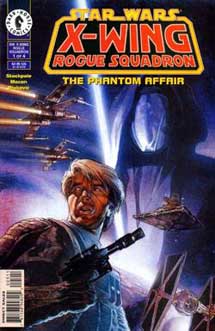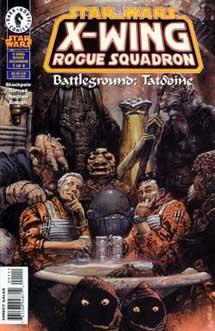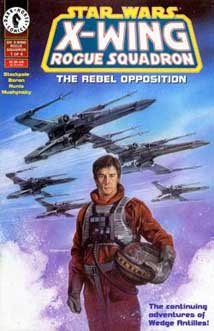Around the same time that Michael Stackpole was writing his “X-Wing” novels in the late 1990s, he was also providing the stories for the 35-issue “X-Wing Rogue Squadron” comic series from Dark Horse. It was quite a juggling act, because all of the comics take place before all of the novels, but many characters appear in both series.
If you love the novels, you’ll appreciate the comics, although your feelings of love might be slow to arrive with the first 12 issues, comprising the four-issue story arcs “The Rebel Opposition” (1995), “The Phantom Affair” (1996) and “Battleground: Tatooine” (1996). At this point in my re-reading, I have to say the novels are far better. I think this is partly because Stackpole is more at home in the world of books, which he had worked in since 1996 (“The Rebel Opposition” was his first comic assignment). It’s also due to the fact that he only provided the stories for the comics; someone else did the scripting duties.
Although “The Rebel Opposition” feels very much like a Stackpole plot, the scripter is Mike Baron, and it’s tempting to blame him for the flaws. As evidence of how hands-off Stackpole was with this arc, he is quoted on Wookieepedia as saying of one of Baron’s creations, the Wookiee Groznik:
“I hated it the second I saw it because it was a retread of the Han Solo/Chewie story. I HATE retreading like that.”
Also, there’s a character named “Derek” who is drawn as a green alien. I wonder if that was supposed to be Derek “Hobbie” Klivian, a veteran (human) Rogue who dates back to the Battle of Hoth.
“The Rebel Opposition” is so filled with errors that for a long time it was one of the few “Star Wars” series not collected in a trade paperback. For example: At one point, Wedge says that Targeter (Winter) is a woman. Later, he says he doesn’t know Targeter’s gender. When the arc was finally collected in an omnibus, some of the word bubbles were rewritten in an attempt to smooth things out.
The highlight of “The Rebel Opposition” is the introduction of Elscol Loro (the woman Groznik protects), who — after “Battleground Tatooine” — will strike out on her own, armed with a gift of supplies from Wedge. Pulling an “Anakin from Episode I” three years before the movie came out, Elscol flies INSIDE a Star Destroyer to blow it up, making Wedge realize she’s a brave freedom fighter, but not good at military discipline. We’ll meet her again when she teams with Iella on a raid in “The Bacta War.” Elscol marks the first of many comic/novel crossovers that make Stackpole’s “X-Wing” saga burst with pleasant surprises for the in-crowd.

“The Phantom Affair” is a vast improvement from the opening arc, but still a bit rough. Issue 5 seems to have pages out of order, at least in my copy (Mirax hangs out with the gang before the scene where they meet her!), and halfway through Issue 8, John Nadeau and Jordi Ensign take over art duties from Edvin Biukovic, who apparently couldn’t meet the deadline. However, Biukovic’s art is gorgeous; it’s particularly cool to see Mirax — Wedge’s childhood friend and future wife of Corran — pop off the page with her fur-rimmed leather jacket, goggles and mop of jet-black hair.

“The Phantom Affair” also gets into the rhythms of Rogue Squadron’s playful banter, particularly between Janson and Hobbie (who will be in some of the novels). We also get to know the dour Plourr and the music-loving, big-eared Sullustan Dllr (who won’t be in the novels).
The comics are less character-driven than the books, but at times we get great character insights. In “The Phantom Affair,” it’s especially neat when we see a flashback to Wedge’s parents being killed in an explosion caused by the Imperial Loka Hask, who has a parasite stuck to half of his face that looks kind of like the “Alien” xenomorph. (I felt like this moment was also chronicled in a Wedge short story, but Wookieepedia tells me that’s not the case.) Then in “Battleground: Tatooine,” we sympathize with Wedge when Biggs Darklighter’s father criticizes Wedge’s Death Star trench actions while lauding his late son.
“The Phantom Affair” is scripter Darko Macan’s best “Star Wars” work; it certainly has more stuff going on than the thin “Vader’s Quest.” However, the lack of a direct Wedge vs. Hask showdown at the end is a strange choice. Then again, I guess Batman never tracked down and killed his parents’ murderers, either. Maybe Hask is the first evil that steeled Wedge’s determination to wipe out as much evil as he can.

Written by Jan Strnad, “Battleground: Tatooine” starts to really build up the “X-Wing” mythology. On the relationship side, Winter and Tycho share their first kiss. On the plot side, Sate Pestage — a major baddie in this comic series, if memory serves — is sort of introduced. In this era when many ambitious Imperials try to carve out their own empires, we learn that Pestage has siphoned off Imperial funds to build a military base hidden in a mountain on Tatooine. (Russ Manning’s comic strips also imagined an Imperial base on Tatooine, but that story is considered apocryphal.)
It’s always fun to return to what is essentially the “Star Wars” homeworld. Strnad also introduces us to a couple of movers-and-shakers on the planet: the gruff Huff Darklighter and the wickedly ambitious Twi’lek Firith Olan, whose body is taken over by Bib Fortuna in a nice twist that continues Fortuna’s arc from “Tales from Jabba’s Palace.” Fortuna’s story hasn’t been continued from this point, further strengthening my argument that more “X-Wing” stories should be told (I advocate for an animated TV series, but books or comics would be cool, too).
As flawed as these first three arcs are, they sold well, perhaps because it was cool to see the beloved characters from the novels visualized by artists (the first three novels were published concurrently with these three arcs). As such, Dark Horse decided to venture beyond the initially planned 12-issue series and keep it going as long as Stackpole had stories to tell and fans bought the comics.

